weight MERCEDES-BENZ B-CLASS HATCHBACK 2008 Owners Manual
[x] Cancel search | Manufacturer: MERCEDES-BENZ, Model Year: 2008, Model line: B-CLASS HATCHBACK, Model: MERCEDES-BENZ B-CLASS HATCHBACK 2008Pages: 305, PDF Size: 5.1 MB
Page 10 of 305
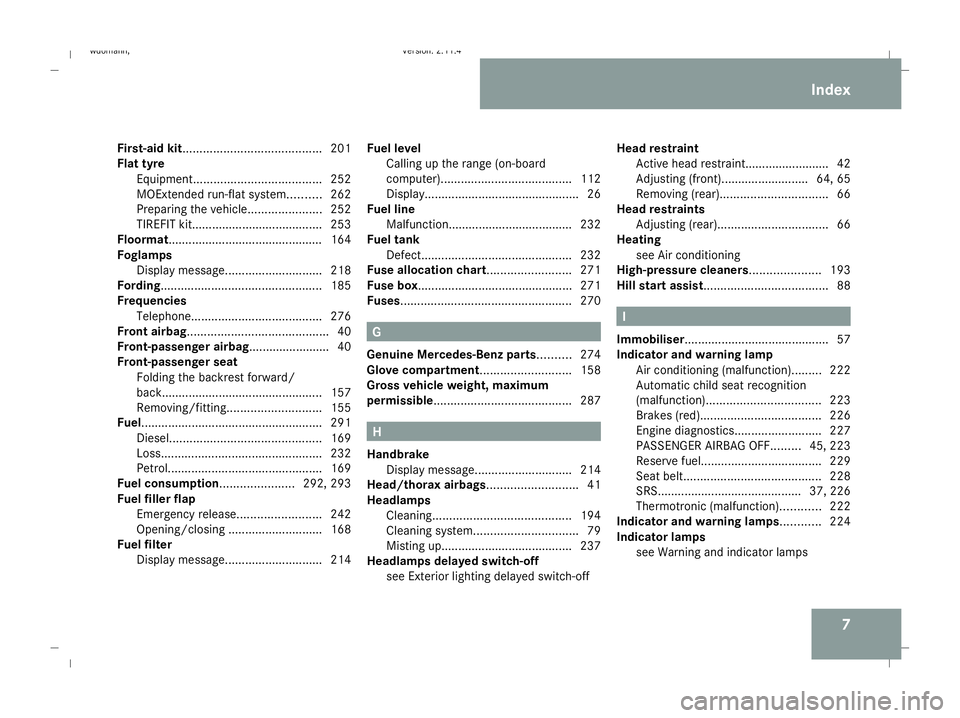
7
First-aid kit.........................................
201
Flat tyre Equipment. ..................................... 252
MOExtended run-flat system ..........262
Preparing the vehicle. .....................252
TIREFIT kit....................................... 253
Floormat............................................. .164
Foglamps Display message ............................. 218
Fording................................................ 185
Frequencies Telephone. ...................................... 276
Front airbag .......................................... 40
Front-passenger airbag ........................ 40
Front-passenger seat Folding the backrest forward/
back................................................ 157
Removing/fitting. ........................... 155
Fuel...................................................... 291
Diesel. ............................................ 169
Loss. ............................................... 232
Petrol .............................................. 169
Fuel consumption...................... 292, 293
Fuel filler flap Emergency release. ........................242
Opening/closing ............................ 168
Fuel filter
Display message ............................. 214Fuel level
Calling up the range (on-board
computer). ...................................... 112
Display. ............................................. 26
Fuel line
Malfunction..................................... 232
Fuel tank
Defect ............................................. 232
Fuse allocation chart......................... 271
Fuse box.............................................. 271
Fuses................................................... 270 G
Genuine Mercedes-Benz parts.......... 274
Glove compartment ...........................158
Gross vehicle weight, maximum
permissible......................................... 287 H
Handbrake Display message ............................. 214
Head/thorax airbags ...........................41
Headlamps Cleaning. ........................................ 194
Cleaning system. .............................. 79
Misting up. ...................................... 237
Headlamps delayed switch-off
see Exterior lighting delayed switch-off Head restraint
Active head restraint......................... 42
Adjusting (front).......................... 64, 65
Removing (rear). ............................... 66
Head restraints
Adjusting (rear). ................................ 66
Heating
see Air conditioning
High-pressure cleaners..................... 193
Hill start assist..................................... 88 I
Immobiliser........................................... 57
Indicator and warning lamp Air conditioning (malfunction) .........222
Automatic child seat recognition
(malfunction). ................................. 223
Brakes (red). ................................... 226
Engine diagnostics ..........................227
PASSENGER AIRBAG OFF .........45, 223
Reserve fuel. ................................... 229
Seat belt. ........................................ 228
SRS........................................... 37, 226
Thermotronic (malfunction) ............222
Indicator and warning lamps............ 224
Indicator lamps see Warning and indicator lamps Index
245_AKB; 2; 7, en-GB
wdomann,
Version: 2.11.4
2008-10-17T11:22:31+02:00 - Seite 7 Dateiname: 6515_1640_02_buchblock.pdf; preflight
Page 15 of 305
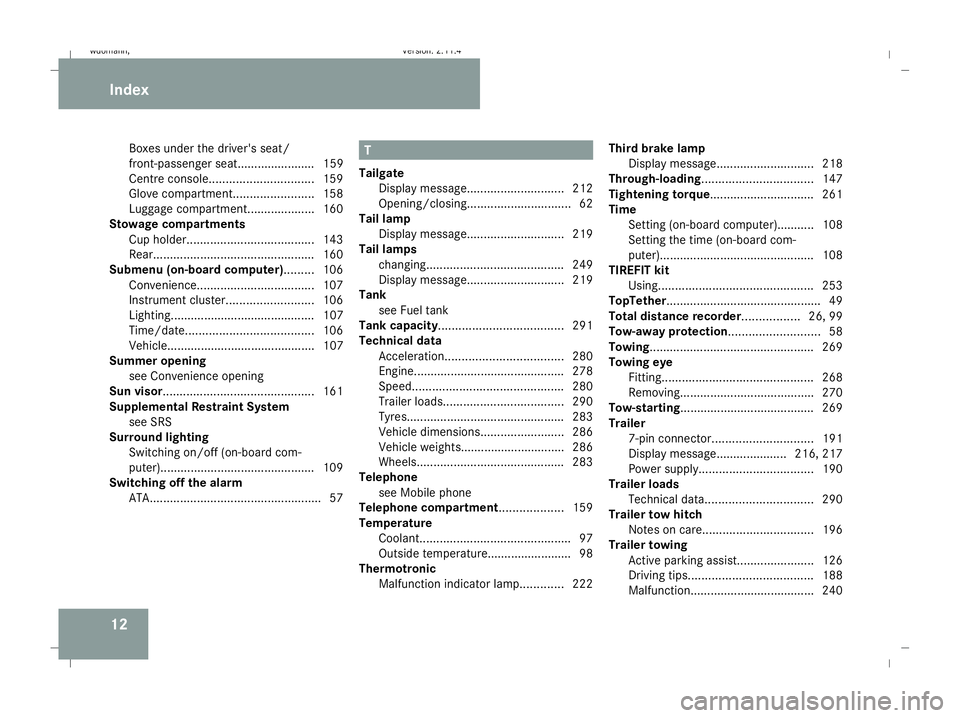
12Boxes under the driver's seat/
front-passenger seat....................... 159
Centre console. .............................. 159
Glove compartment. .......................158
Luggage compartment. ...................160
Stowage compartments
Cup holder ...................................... 143
Rear. ............................................... 160
Submenu (on-board computer)......... 106
Convenience ................................... 107
Instrument cluster .......................... 106
Lighting........................................... 107
Time/date. ..................................... 106
Vehicle............................................ 107
Summer opening
see Convenience opening
Sun visor............................................. 161
Supplemental Restraint System see SRS
Surround lighting
Switching on/off (on-board com-
puter). ............................................. 109
Switching off the alarm
ATA. .................................................. 57 T
Tailgate Display message ............................. 212
Opening/closing. .............................. 62
Tail lamp
Display message ............................. 219
Tail lamps
changing. ........................................ 249
Display message ............................. 219
Tank
see Fuel tank
Tank capacity ..................................... 291
Technical data Acceleration. .................................. 280
Engine............................................ .278
Speed. ............................................ 280
Trailer loads .................................... 290
Tyres. .............................................. 283
Vehicle dimensions. ........................286
Vehicle weights............................... 286
Wheels. ........................................... 283
Telephone
see Mobile phone
Telephone compartment ...................159
Temperature Coolant. ............................................ 97
Outside temperature......................... 98
Thermotronic
Malfunction indicator lamp. ............222Third brake lamp
Display message ............................. 218
Through-loading ................................. 147
Tightening torque............................... 261
Time Setting (on-board computer).......... .108
Setting the time (on-board com-
puter). ............................................. 108
TIREFIT kit
Using. ............................................. 253
TopTether .............................................. 49
Total distance recorder................. 26, 99
Tow-away protection........................... 58
Towing................................................. 269
Towing eye Fitting ............................................. 268
Removing....................................... .270
Tow-starting ........................................ 269
Trailer 7-pin connector .............................. 191
Display message..................... 216, 217
Power supply. ................................. 190
Trailer loads
Technical data. ............................... 290
Trailer tow hitch
Notes on care ................................. 196
Trailer towing
Active parking assist .......................126
Driving tips ..................................... 188
Malfunction..................................... 240 Index
245_AKB; 2; 7, en-GB
wdomann,
Version: 2.11.4 2008-10-17T11:22:31+02:00 - Seite 12Dateiname: 6515_1640_02_buchblock.pdf; preflight
Page 16 of 305

13
Mounting dimensions.
....................289
Parktronic. ...................................... 122
Transmission
Display message ............................. 209
Transmission output (maximum)
Telephone/two-way radio ...............275
Transport (vehicle)............................. 270
Trip computer Menu (on-board computer). ............111
Trip meter ............................... 26, 99, 101
Resetting. ......................................... 97
Turn signal lamps
Display message ............................. 217
Two-way radio
Installation. ..................................... 275
Tyre grip .............................................. 184
Tyre pressure ..................................... 178
Display message ............................. 211
Tyre pressure loss warning system.1 79
Tyres Direction of rotatio n....................... 177
General notes. ................................ 176
Technical data. ............................... 283
Tyre tread ............................................ 178 U
Unladen weight.................................. 287
Unlocking Emergency unlocking...................... 241
From the inside (central unlocking
button) .............................................. 61 V
Variable Speedtronic .........................117
Vehicle Emergency unlocking .............241, 242
Individual settings (on-board com-
puter). ............................................. 105
Leaving parked up. .........................240
Towing. ........................................... 269
Tow-starting .................................... 269
Transporting ................................... 270
Vehicle battery................................... 263
Vehicle dimensions ............................286
Vehicle electronics ............................275
Vehicle identification number (VIN).2 77
Vehicle identification plates............. 276
Vehicle tool kit................................... 200
Vehicle weights.................................. 286
Video DVD Operating (on-board computer). .....104 W
Warning and indicator lamp ABS (yellow).................................... 224
LIM (cruise control)......................... 115
LIM (variable Speedtronic). .............117
Warning and indicator lamps
ESP ®
......................................... 56, 226
Warning signal
Audible. .......................................... 230
Warning triangle................................. 201
Washer fluid
Display message ............................. 221
Washer fluid reservoir .......................299
Filling capacity. ............................... 299
Wearing seat belts............................... 72
Wheel bolts Tightening torque............................ 261
Wheel chock
Use. ................................................ 200
Wheels
General notes. ................................ 176
Interchanging.................................. 181
Technical data. ............................... 283
Windowbags......................................... 42
Windows Cleaning. ........................................ 194
Cleaning the windscreen ...............194
see Side windows Index
245_AKB; 2; 7, en-GB
wdomann,
Version: 2.11.4
2008-10-17T11:22:31+02:00 - Seite 13 Dateiname: 6515_1640_02_buchblock.pdf; preflight
Page 18 of 305
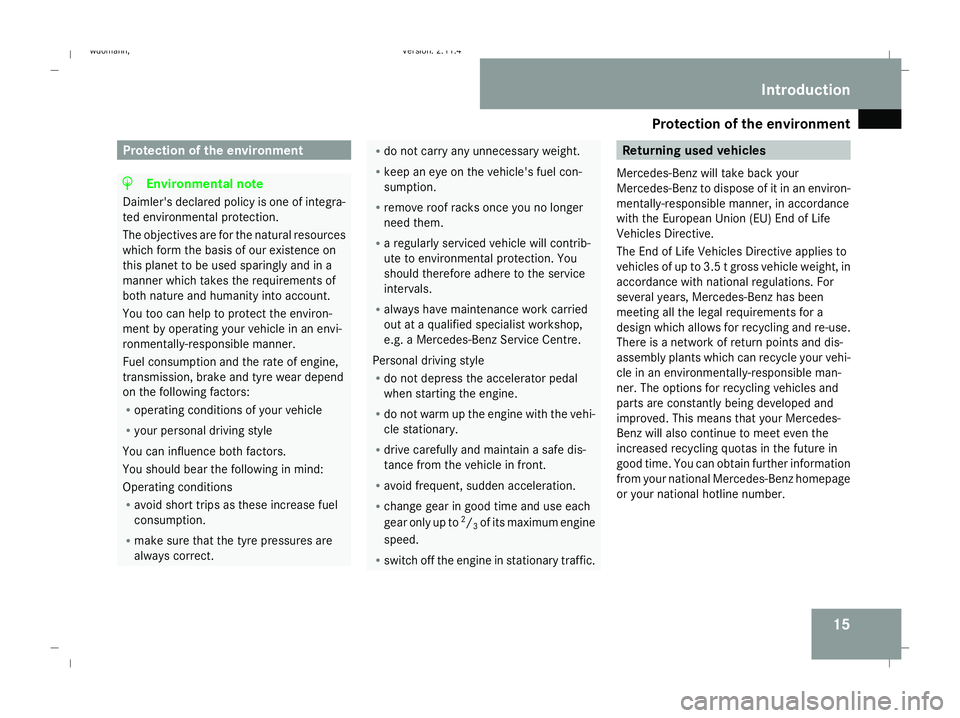
Protection of the environment
15Protection of the environment
H
Environmental note
Daimler's declared policy is one of integra-
ted environmental protection.
The objectives are for the natural resources
which form the basis of our existence on
this planet to be used sparingly and in a
manner which takes the requirements of
both nature and humanity into account.
You too can help to protect the environ-
ment by operating your vehicle in an envi-
ronmentally-responsible manner.
Fuel consumption and the rate of engine,
transmission, brake and tyre wear depend
on the following factors:
R operating conditions of your vehicle
R your personal driving style
You can influence both factors.
You should bear the following in mind:
Operating conditions
R avoid short trips as these increase fuel
consumption.
R make sure that the tyre pressures are
always correct. R
do not carry any unnecessary weight.
R keep an eye on the vehicle's fuel con-
sumption.
R remove roof racks once you no longer
need them.
R a regularly serviced vehicle will contrib-
ute to environmental protection. You
should therefore adhere to the service
intervals.
R always have maintenance work carried
out at a qualified specialist workshop,
e.g. a Mercedes-Benz Service Centre.
Personal driving style
R do not depress the accelerator pedal
when starting the engine.
R do not warm up the engine with the vehi-
cle stationary.
R drive carefully and maintain a safe dis-
tance from the vehicle in front.
R avoid frequent, sudden acceleration.
R change gear in good time and use each
gear only up to 2
/ 3of its maximum engine
speed.
R switch off the engine in stationary traffic. Returning used vehicles
Mercedes-Benz will take back your
Mercedes-Benz to dispose of it in an environ-
mentally-responsible manner, in accordance
with the European Union (EU) End of Life
Vehicles Directive.
The End of Life Vehicles Directive applies to
vehicles of up to 3.5 t gross vehicle weight, in
accordance with national regulations. For
several years, Mercedes-Benz has been
meeting all the legal requirements for a
design which allows for recycling and re-use.
There is a network of return points and dis-
assembly plants which can recycle your vehi-
cle in an environmentally-responsible man-
ner. The options for recycling vehicles and
parts are constantly being developed and
improved. This means that your Mercedes-
Benz will also continue to meet even the
increased recycling quotas in the future in
good time. You can obtain further information
from your national Mercedes-Benz homepage
or your national hotline number. Introduction
245_AKB; 2; 7, en-GB
wdomann,
Version: 2.11.4
2008-10-17T11:22:31+02:00 - Seite 15 ZDateiname: 6515_1640_02_buchblock.pdf; preflight
Page 49 of 305
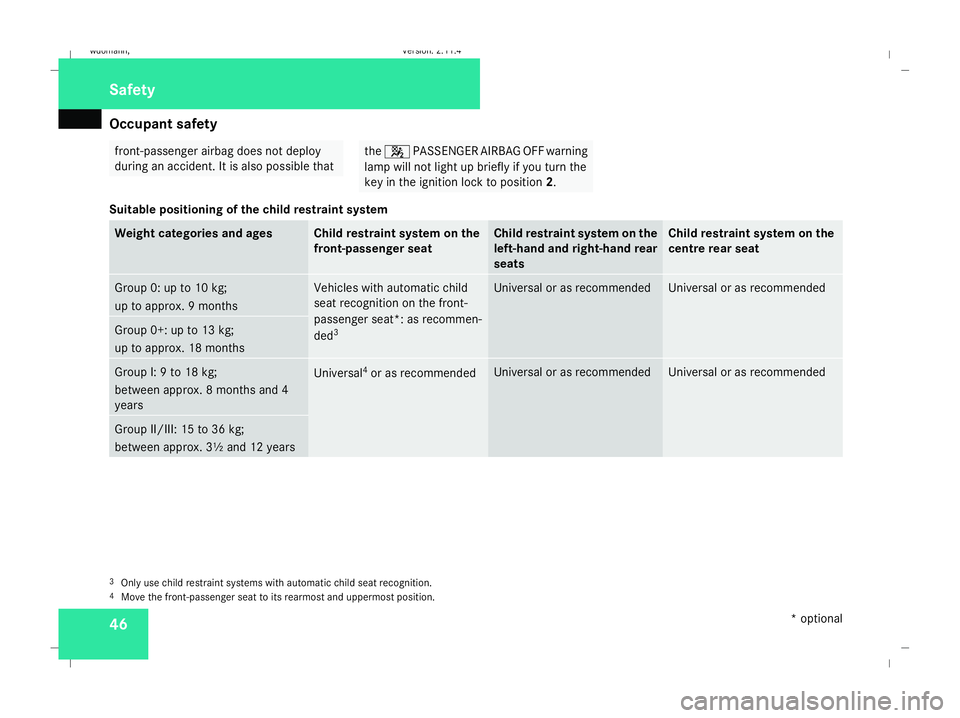
Occupant safety
46 front-passenger airbag does not deploy
during an accident. It is also possible that the
4 PASSENGER AIRBAG OFF warning
lamp will not light up briefly if you turn the
key in the ignition lock to position 2.
Suitable positioning of the child restraint system Weight categories and ages Child restraint system on the
front-passenger seat Child restraint system on the
left-hand and right-hand rear
seats Child restraint system on the
centre rear seat
Group 0: up to 10 kg;
up to approx. 9 months Vehicles with automatic child
seat recognition on the front-
passenger seat*: as recommen-
ded 3 Universal or as recommended Universal or as recommended
Group 0+: up to 13 kg;
up to approx. 18 months
Group I: 9 to 18 kg;
between approx. 8 months and 4
years Universal
4
or as recommended Universal or as recommended Universal or as recommended
Group II/III: 15 to 36 kg;
between approx. 3½ and 12 years 3
Only use child restraint systems with automatic child seat recognition.
4 Move the front-passenger seat to its rearmost and uppermost position. Safety
* optional
245_AKB; 2; 7, en-GB
wdomann
,V ersion: 2.11.4
2008-10-17T11:22:31+02:00 - Seite 46 Dateiname: 6515_1640_02_buchblock.pdf; preflight
Page 50 of 305

Occupant safety
47
"Universal" category child restraint systems
can be recognised by their orange approval
label. Example of an approval label on the child restraint
system
Recommended child restraint systems Weight categories and
ages Manufacturer Type Approval number Daimler order num-
ber Automatic child seat
recognition
Group 0: up to 10 kg;
up to approx. 9 months Britax-Römer BABY SAFE
PLUS
5 E1 03 301146 A 000 970 10 00 Yes
BABY SAFE ISO-
FIX PLUS B6 6 86 8224
no
6 Group 0+: up to 13 kg;
up to approx. 18 months Britax-Römer BABY SAFE
PLUS
5 E1 03 301146 A 000 970 10 00 Yes
BABY SAFE ISO-
FIX PLUS B6 6 86 8224
No
6 5
Move the front-passenger seat to the highest position.
6 The child restraint system may only be fitted to the left-hand and right-hand rear seats. Safety
245_AKB; 2; 7, en-GB
wdomann,
Version: 2.11.4
2008-10-17T11:22:31+02:00 - Seite 47 ZDateiname: 6515_1640_02_buchblock.pdf; preflight
Page 51 of 305
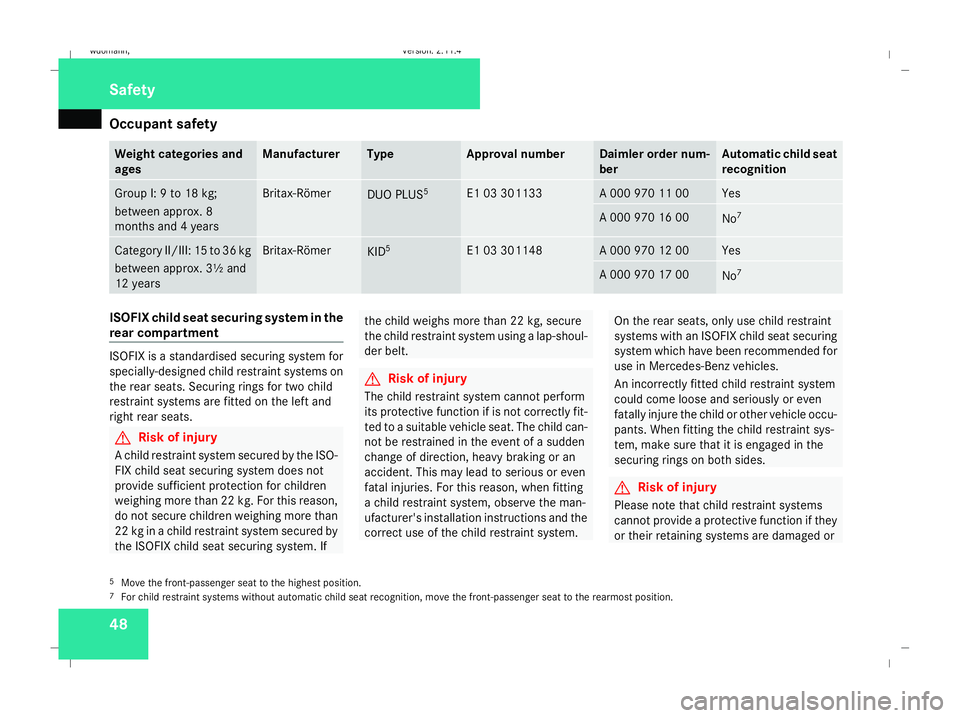
Occupant safety
48 Weight categories and
ages Manufacturer Type Approval number Daimler order num-
ber Automatic child seat
recognition
Group I: 9 to 18 kg;
between approx. 8
months and 4 years Britax-Römer
DUO PLUS
5 E1 03 301133 A 000 970 11 00 Yes
A 000 970 16 00
No
7 Category II/III: 15 to 36 kg
between approx. 3½ and
12 years Britax-Römer
KID
5 E1 03 301148 A 000 970 12 00 Yes
A 000 970 17 00
No
7 ISOFIX child seat securing system in the
rear compartment
ISOFIX is a standardised securing system for
specially-designed child restraint systems on
the rear seats. Securing rings for two child
restraint systems are fitted on the left and
right rear seats. G
Risk of injury
A child restraint system secured by the ISO-
FIX child seat securing system does not
provide sufficient protection for children
weighing more than 22 kg. For this reason,
do not secure children weighing more than
22 kg in a child restraint system secured by
the ISOFIX child seat securing system. If the child weighs more than 22 kg, secure
the child restraint system using a lap-shoul-
der belt. G
Risk of injury
The child restraint system cannot perform
its protective function if is not correctly fit-
ted to a suitable vehicle seat. The child can-
not be restrained in the event of a sudden
change of direction, heavy braking or an
accident. This may lead to serious or even
fatal injuries. For this reason, when fitting
a child restraint system, observe the man-
ufacturer's installation instructions and the
correct use of the child restraint system. On the rear seats, only use child restraint
systems with an ISOFIX child seat securing
system which have been recommended for
use in Mercedes-Benz vehicles.
An incorrectly fitted child restraint system
could come loose and seriously or even
fatally injure the child or other vehicle occu-
pants. When fitting the child restraint sys-
tem, make sure that it is engaged in the
securing rings on both sides.
G
Risk of injury
Please note that child restraint systems
cannot provide a protective function if they
or their retaining systems are damaged or
5 Move the front-passenger seat to the highest position.
7 For child restraint systems without automatic child seat recognition, move the front-passenger seat to the rearmost position. Safety
245_AKB; 2; 7, en-GB
wdomann
,V ersion: 2.11.4
2008-10-17T11:22:31+02:00 - Seite 48 Dateiname: 6515_1640_02_buchblock.pdf; preflight
Page 53 of 305

Occupant safety
50Make sure you do not route the belt across
luggage compartment cover
3.
X Swing back rear seat backrest 2until it
engages.
The red lock verification indicator is no lon-
ger visible (Y page 150). G
Risk of injury
Make sure that the rear seat backrest is
fully locked. The red lock verification indi-
cators on the left and right should no longer
be visible. If they are, the rear seat backr-
ests are not locked. If this is the case, occu-
pants could be injured in the event of an
accident, e.g. by objects being thrown for-
wards from the luggage compartment.
X Move head restraint 1back down again
slightly if necessary (Y page 66). Make
sure that you do not interfere with the cor-
rect routing of TopTether belt* 6.
X Install the ISOFIX child restraint system
with TopTether*. Comply with the manu-
facturer's installation instructions.
Integrated child seat* The child seats are integrated into the right
and left-hand sides of the seats of the rear bench seat. They comply with the legal
requirements of ECE Regulation 44.03.
Mercedes-Benz recommends the integrated
child seat for children from approximately
two to twelve years of age or with a body
weight of 12.5 kg to 36 kg.
For children between approximately two and
four years of age or weighing between
approximately 12.5 kg and 22 kg, you must
also use a padded table* which has been spe-
cially approved for the integrated child seat
(Y page 51). G
Risk of injury
To reduce the risk of serious or even fatal
injury to the child in the event of a sudden
change in direction, braking or an accident:
R Do not modify the integrated child seat.
R When the child seat is occupied, adjust
the head restraint to a position at which
the back of the child's head is supported
by the centre of the head restraint at
about eye level.
R Replace an integrated child seat that has
been damaged or subjected to a heavy
load as the result of an accident.
R Be aware that children under two years
of age require a different child restraint system. Information about other child
restraint systems is available from any
Mercedes-Benz Service Centre.
R The rear seat backrest in the vehicle
must be securely locked in position.
Folding out the child seat 1
Release catch
2 Hook
X Press release catch 1.
The child seat folds upwards.
X Push the child seat back to the stop so that
it engages. Safety
* optional
245_AKB; 2; 7, en-GB
wdomann
,V ersion: 2.11.4
2008-10-17T11:22:31+02:00 - Seite 50 Dateiname: 6515_1640_02_buchblock.pdf; preflight
Page 54 of 305
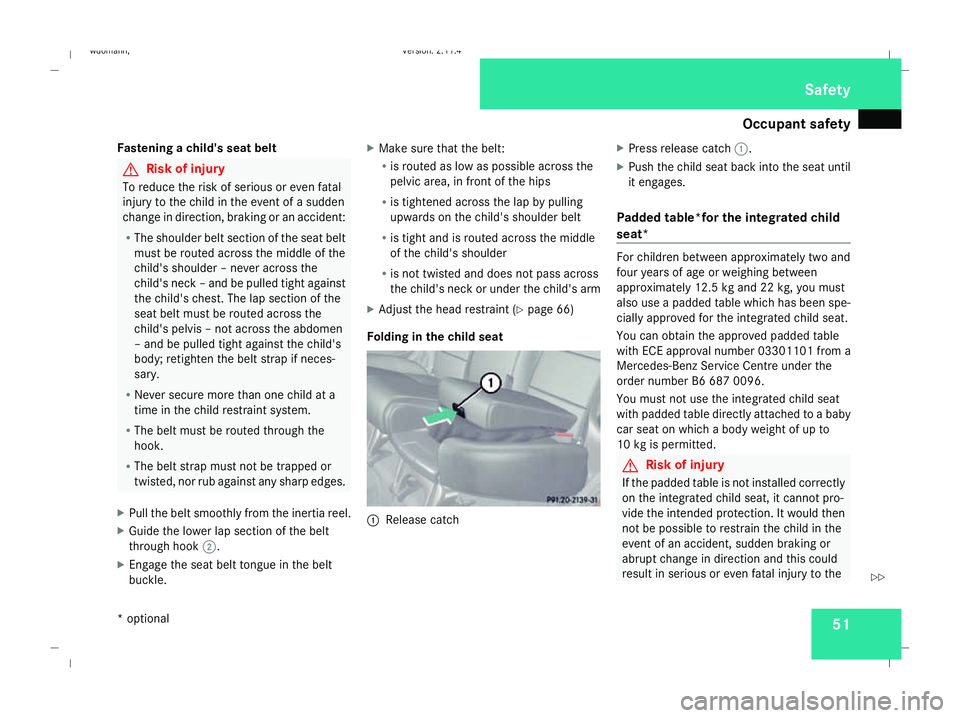
Occupant safety
51
Fastening a child's seat belt G
Risk of injury
To reduce the risk of serious or even fatal
injury to the child in the event of a sudden
change in direction, braking or an accident:
R The shoulder belt section of the seat belt
must be routed across the middle of the
child's shoulder – never across the
child's neck – and be pulled tight against
the child's chest. The lap section of the
seat belt must be routed across the
child's pelvis – not across the abdomen
– and be pulled tight against the child's
body; retighten the belt strap if neces-
sary.
R Never secure more than one child at a
time in the child restraint system.
R The belt must be routed through the
hook.
R The belt strap must not be trapped or
twisted, nor rub against any sharp edges.
X Pull the belt smoothly from the inertia reel.
X Guide the lower lap section of the belt
through hook 2.
X Engage the seat belt tongue in the belt
buckle. X
Make sure that the belt:
R
is routed as low as possible across the
pelvic area, in front of the hips
R is tightened across the lap by pulling
upwards on the child's shoulder belt
R is tight and is routed across the middle
of the child's shoulder
R is not twisted and does not pass across
the child's neck or under the child's arm
X Adjust the head restraint (Y page 66)
Folding in the child seat 1
Release catch X
Press release catch 1.
X Push the child seat back into the seat until
it engages.
Padded table*for the integrated child
seat* For children between approximately two and
four years of age or weighing between
approximately 12.5 kg and 22 kg, you must
also use a padded table which has been spe-
cially approved for the integrated child seat.
You can obtain the approved padded table
with ECE approval number 03301101 from a
Mercedes-Benz Service Centre under the
order number B6 687 0096.
You must not use the integrated child seat
with padded table directly attached to a baby
car seat on which a body weight of up to
10 kg is permitted.
G
Risk of injury
If the padded table is not installed correctly
on the integrated child seat, it cannot pro-
vide the intended protection. It would then
not be possible to restrain the child in the
event of an accident, sudden braking or
abrupt change in direction and this could
result in serious or even fatal injury to the Safety
* optional
245_AKB; 2; 7, en-GB
wdomann,
Version: 2.11.4 2008-10-17T11:22:31+02:00 - Seite 51 ZDateiname: 6515_1640_02_buchblock.pdf; preflight
Page 147 of 305

Loading and stowing
144Benz vehicles. This helps to prevent dam-
age to the vehicle.
Position the load on the roof rack in such a
way that the vehicle will not sustain dam-
age even when it is in motion.
Depending on the vehicle's equipment,
make sure that you can:
R open the panorama louvred sliding sun-
roof* fully
R open the tailgate fully 1
Covers
X Fold covers 1upwards.
X Only secure the roof rack to the anchorage
points under covers 1. Observe the manufacturer's installation
instructions. Luggage net
G
Risk of injury
Only place lightweight items in the luggage
net. Do not use it to transport heavy, bulky,
sharp-edged or fragile objects. In the event
of an accident, the luggage net will not
secure the transported goods. Loading guidelines
G
Risk of injury
Secure and position the load as described
in the loading guidelines.
Otherwise, vehicle occupants could
be injured by the load being thrown around
in the event of sharp braking, a sudden
change in direction or an accident. This also
applies to seats which have been removed.
You will find further information in the
"Securing a load" section.
Even if you follow all the loading guidelines,
the load will increase the risk of injury in the
event of an accident. G
Risk of poisoning
Keep the tailgate closed when the engine is
running. Otherwise, you could be poisoned
by exhaust fumes entering the vehicle.
The handling characteristics of a laden vehi-
cle depend on the distribution of the load
within the vehicle. You should therefore load
your vehicle as shown in the illustrations. Observe the following notes when transport-
ing a load:
R
When transporting a load, never exceed the
maximum permissible gross vehicle weight
or the permissible axle loads for the vehicle
(including occupants).
R Position heavy loads as far forwards and as
low down in the luggage compartment as
possible.
R The load must not protrude above the
upper edge of the backrests. Controls
245_AKB; 2; 7, en-GB
wdomann,
Version: 2.11.4
2008-10-17T11:22:31+02:00 - Seite 144 Dateiname: 6515_1640_02_buchblock.pdf; preflight